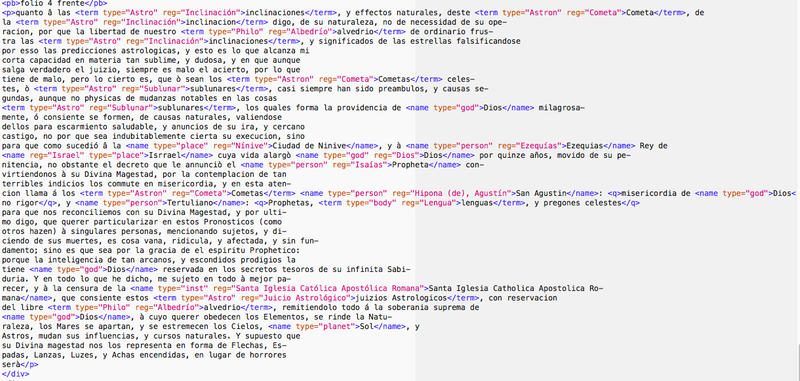Guest blog by Ernesto Priani

Ernesto Priani
In this guest blog, Ernesto Priani of UNAM (National Autonomous University of Mexico) talks about linguistic dimensions to electronic markup, with particular focus on the Text Encoding Initiative, a set of guidelines widely used by researchers, publishers and libraries for marking up digital texts. UNAM is one of the project partners for the Digital Mediations strand.
In a text from 2003, which reflects on whether or not the guidelines used in the TEI markup scheme should be translated into Spanish for documents marked up by the Cervantes Virtual Library, Alejandro Bia and Manuel Sánchez-Quero wrote:
“We learned from practice that using a tagset in a foreign language, compared to using a tagset in our own language, increases the learning time and reduces the quality and amount of digital text production, since tag names are mnemonics that may sound familiar to English speakers but are hard to understand and memorize by users of other languages. Giving our encoders the possibility of applying tags in Spanish has increased the amount and quality of digital text production” Bia, Sánchez-Quero (2003).
While this reflection has a pragmatic element – the pace of learning and the quality of the markup speed up as categories are memorised more quickly, leading to them being assigned with greater security; their observation also sheds light on a subject which emerges through the digitisation process: encoding process includes, within the text and for its digital representation, tags which are defined by a language which in many cases is different from that of the person doing the markup or that of the original person who produced the text being marked up.
The question which underlies my current research explicitly emerges from this fact. What are the epistemological, cultural and political implications behind this inclusion of one language within another for its digital representation? In particular when one considers that the use of the TEI guidelines has specific objectives in terms of analysis, and in terms of its textual and linguistic study; and above all the fact that it is embedded within the text, as text.

My approach to this question take into account the fact that, as Marck Marino says, code does not exist solely for computers, but also for programmers, in other words for the people who code (and by way of extension, I would add those who study digitised texts and digitisation tools). For that reason I propose that we should start to analyse code not from the perspective of practical results, or in terms of the efficiency of its computational method, but as a text which contains its own rhetoric, and which, in our case ends up forming part of the text which it marks up.
Consequently, following what Domenico Fiormonte et al. state in Politics of the code, I also acknowledge that: “digital ‘standards’ always reflect a cultural bias, and that the level of encoding is never neutral, but tends to assume (and overlap with) universalising discourses that are usually invisible at the surface of technology.”
In this way my study aims to explore how epistemological considerations, cultural variants and political structures are inserted within a text as part of an epistemologicial operation – since text markup always implies an operation of this type – which includes transferring concepts in one language (that of the text) into another (that of the markup) in order that it be captured in code.
In my own experience of markup, and of guiding my students’ markup practices, one issue which has always emerged has been the fact that a reading of a text is always conditioned by the possible interpretations which are permitted by a particular set of markup choices. What we did not notice back then, were the consequences which this set of conditions implies.
Translation by Paul Spence
References
Alejandro Bia and Manuel Sánchez-Quero. Multilingual Markup Automation for Better Document Production and Retrieval. In JOTRI 2003 - II Jornadas de Tratamiento y Recuperación de la Información, pages 281-288, (Universidad Carlos III, Leganés (Madrid)) 8-9 September 2003. Departamento de Biblioteconomía y Documentación y Departamento de Informática de la Universidad Carlos III de Madrid.
Marino, Mark C. “Critical Code Studies”. Electronic Book Review. 2006. http://www.electronicbookreview.com/thread/electropoetics/codology
Fiormonte, Domenico, Desmond Schmidt , Paolo Monella, Paolo Sordi (2015) The politics of code. How digital representations and languages shape culture. Extended Abstract, ICTs & Society Conference. http://infolet.it/files/2015/06/politics-of-code-fiormonte-et-al-def.pdf
Ernesto Priani Saisó y Ana María Guzmán Olmos «tei como una nueva práctica de lectura»
Humanidades Digitales: desafíos, logros y perspectivas de futuro. Janus, Anexo 1 (2014), pp. 373-382. http://www.janusdigital.es/anexos/contribucion/descargar.htm?id=34